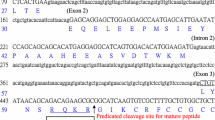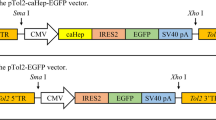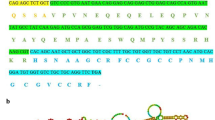Abstract
Antimicrobial peptides are considered as effector immune molecules and during last decades, many workers have demonstrated the significant role and mechanism of hepcidin (hamp), an antimicrobial peptide in regulating the absorption, transport, storage and mobilization of iron. In the present work, hepcidin cDNA was cloned, sequenced and characterized in an important medium carp species, Puntius sarana, which is enlisted as a vulnerable species. The tissue specificity of hepcidin was checked in major organs of this species, and expression profile of hepcidin transcript was analyzed during ontogeny and infection against a common bacterial pathogen, Aeromonas hydrophila. Further, the antimicrobial activity of hepcidin was investigated against various Gram positive and negative bacterial strains, using the synthetic mature peptide of P. sarana. The obtained hamp amplicon produced a predicted ORF of 279 bases having 92 amino acids and the nucleotide sequence showed 99 % identity with zebrafish hepcidin. During the ontogeny, the hamp gene appeared at 6 h post-fertilization and its expression remained constant towards 21 days post-fertilization and was intensely observed in liver as compared to other organs. After artificial exposure to A. hydrophila, up-regulation of the gene was marked at 3 and 6 h post-challenge, however, the same was down regulated after 24 h onwards. The synthetic hepcidin peptide exhibited broad spectrum antibacterial activity against important fish pathogens at a concentration of 17.30 µM. This preliminary study revealed that hepcidin might be playing an important role in innate defence of this fish species.







Similar content being viewed by others
References
Cai L, Cai J, Liu HP, Fan DQ, Peng H, Wang KJ (2012) Recombinant medaka (Oryzias melastigmus) pro-hepcidin: multifunctional characterization. Comp Biochem Physiol 161:140–147
Chen SL, Xu MY, Ji XS, Yu GC, Liu Y (2005) Cloning, characterization, and expression analysis of hepcidin gene from red sea bream (Chrysophrys major). Antimicrob Agents Chemother 49:1608–1612
Cole AM, Weis P, Diamond G (1997) Isolation and characterization of pleurocidin, an antimicrobial peptide in the skin secretions of winter flounder. J Biol Chem 272:12008–12013
Cuesta A, Meseguer J, Esteban MA (2008) The antimicrobial peptide hepcidin exerts an important role in the innate immunity against bacteria in the bony fish gilthead seabream. Mol Immunol 45:2333–2342
Das A, Sahoo PK, Mohanty BR, Jena JK (2011) Pathophysiology of experimental Aeromonas hydrophila infection in Puntius sarana: early changes in blood and aspects of the innate immune-related gene expression in survivors. Vet Immunol Immunopathol 142:207–218
Douglas SE, Gallant JW, Liebscher RS, Dacanay A, Tsoi SC (2003) Identification and expression analysis of hepcidin-like antimicrobial peptides in bony fish. Dev Comp Immunol 27:589–601
Ganz T (2003) Hepcidin, a key regulator of iron metabolism and mediator of anemia of inflammation. Blood 102:783–788
Hirono I, Hwang JY, Ono Y, Kurobe T, Ohira T, Nozaki R, Aoki T (2005) Two different types of hepcidins from the Japanese flounder Paralichthys olivaceus. FEBS J 272:5257–5264
Hossain MY, Ohtomi J, Faruque Ahmed Z (2009) Morphometric, meristic characteristics and conservation of the threatened fish, Puntius sarana (Hamilton, 1822) (Cyprinidae) in the Ganges river, northwestern Bangladesh. Turk J Fish Aquat Sc 9:223–225
Iijima R, Kisugi J, Yamazaki M (2003) A novel antimicrobial peptide from the sea hare Dolabella auricularia. Dev Comp Immunol 27:305–311
Kim YO, Park EM, Nam BH, Kong HJ, Kim WJ, Lee SJ (2008) Identification and molecular characterization of two hepcidin genes from black rockfish (Sebastes schlegelii). Mol Cell Biochem 315:131–136
Krause A, Neitz S, Mägert HJ, Schulz A, Forssmann WG, Schulz-Knappe P, Adermann K (2000) LEAP-1, a novel highly disulfide-bonded human peptide, exhibits antimicrobial activity. FEBS Lett 480:147–150
Lakra WS (2010) Threatened freshwater fishes of India. National Bureau of Fish Genetic and Resources Publ, Lucknow 17
Martin-Antonio B, Jiménez-Cantizano R, Salas-Leiton E, Infante C, Machado M (2009) Genomic characterization and gene expression analysis of four hepcidin genes in the red banded seabream (Pagrus auriga). Fish Shellfish Immunol 26:483–491
Masso-Silva J, Diamond G, Macias-Rodriguez M, Ascencio F (2011) Genomic organization and tissue-specific expression of hepcidin in the pacific mutton hamlet, Alphestes immaculatus (Breder, 1936). Fish Shellfish Immunol 31:1297–1302
Nicolas P, Vanhoye D, Amiche M (2003) Molecular strategies in biological evolution of antimicrobial peptides. Peptides 24:1669–1680
Pereiro P, Figueras A, Novoa B (2012) A novel hepcidin-like in turbot (Scophthalmus maximus L.) highly expressed after pathogen challenge but not after iron overload. Fish Shellfish Immunol 32:879–889
Rajanbabu V, Pan CY, Lee SC, Lin WJ, Lin CC, Li CL (2010) Tilapia hepcidin 2–3 peptide modulates lipopolysaccharide-induced cytokines and inhibits tumor necrosis factor-alpha through cyclooxygenase-2 and phosphodiesterase 4D. J Biol Chem 285:30577–30586
Ravichandran S, Kumaravel K, Rameshkumar G, Ajith Kumar TT (2010) Antimicrobial peptides from the marine fishes. Res J Immunol 3:146–156
Reed LJ, Muench H (1938) A simple method of estimating fifty percent end points. Am J Hyg 27:493–497
Rossi E (2005) Hepcidin: the iron regulatory hormone. Clin Biochem Rev 26:47–49
Sahoo PK, Mukherjee SC, Sahoo SK (1998) Aeromonas hydrophila versus Edwardsiella tarda: a pathoanatomical study in Clarias batrachus. J Aqua 6:57–66
Saitou N, Nei M (1987) The neighbor-joining method: a new method for reconstructing phylogenetic trees. Mol Biol Evol 4:406–425
Shi J, Camus AC (2006) Hepcidins in amphibians and fishes: antimicrobial peptides or iron-regulatory hormones? Dev Comp Immunol 30:746–755
Shike H, Lauth X, Westerman ME, Ostland VE, Carlberg JM, Olst JCV, Shimizu C, Bulet P, Burns JC (2002) Bass hepcidin is a novel antimicrobial peptide induced by bacterial challenge. Eur J Biochem 269:2232–2237
Thompson JD, Higgins DG, Gibson TJ (1994) CLUSTAL W: improving the sensitivity of progressive multiple sequence alignment through sequence weighting, position-specific gap penalties and weight matrix choice. Nucleic Acids Res 22:4673–4780
Verga Falzacappa MV, Muckenthaler MU (2005) Hepcidin: iron-hormone and anti-microbial peptide. Gene 364:37–44
Weinstein DA, Roy CN, Fleming MD, Loda MF, Wolfsdorf JI, Andrews NC (2002) Inappropriate expression of hepcidin is associated with iron refractory anemia: implications for the anemia of chronic disease. Blood 100:3776–3781
Wimley WC, Hristova K (2011) Antimicrobial peptides: successes, challenges and unanswered questions. J Membr Biol 239:27–34
Yang M, Wang K, Chen J, Du H, Li S (2007) Genomic organization and tissue-specific expression analysis of hepcidin-like genes from black porgy (Acanthopagrus schlegelii B.). Fish Shellfish Immunol 23:1060–1071
Conflict of Interest
Abhilipsa Das, Amruta Mohapatra and P.K. Sahoo herewith declare that they have no conflict of interest.
Human and Animal Rights and Informed Consent
The experiments conducted during the present study were approved by the Institute Animal Ethics Committee.
Author information
Authors and Affiliations
Corresponding author
Rights and permissions
About this article
Cite this article
Das, A., Mohapatra, A. & Sahoo, P.K. Cloning and Characterization of Antimicrobial Peptide, Hepcidin in Medium Carp, Puntius sarana . Int J Pept Res Ther 21, 139–147 (2015). https://doi.org/10.1007/s10989-014-9438-4
Accepted:
Published:
Issue Date:
DOI: https://doi.org/10.1007/s10989-014-9438-4




